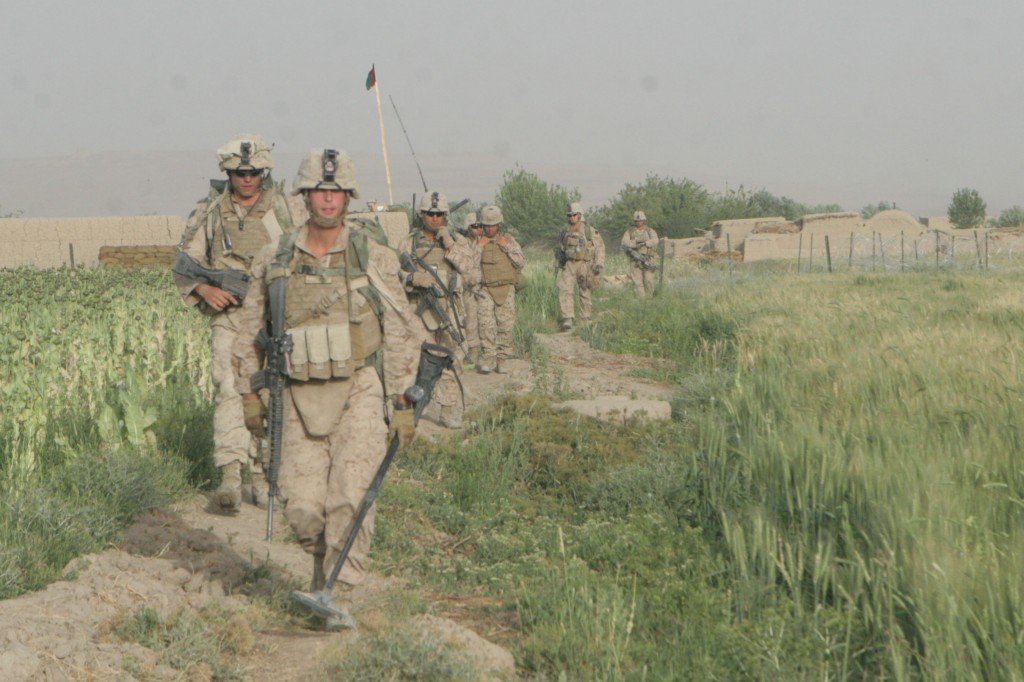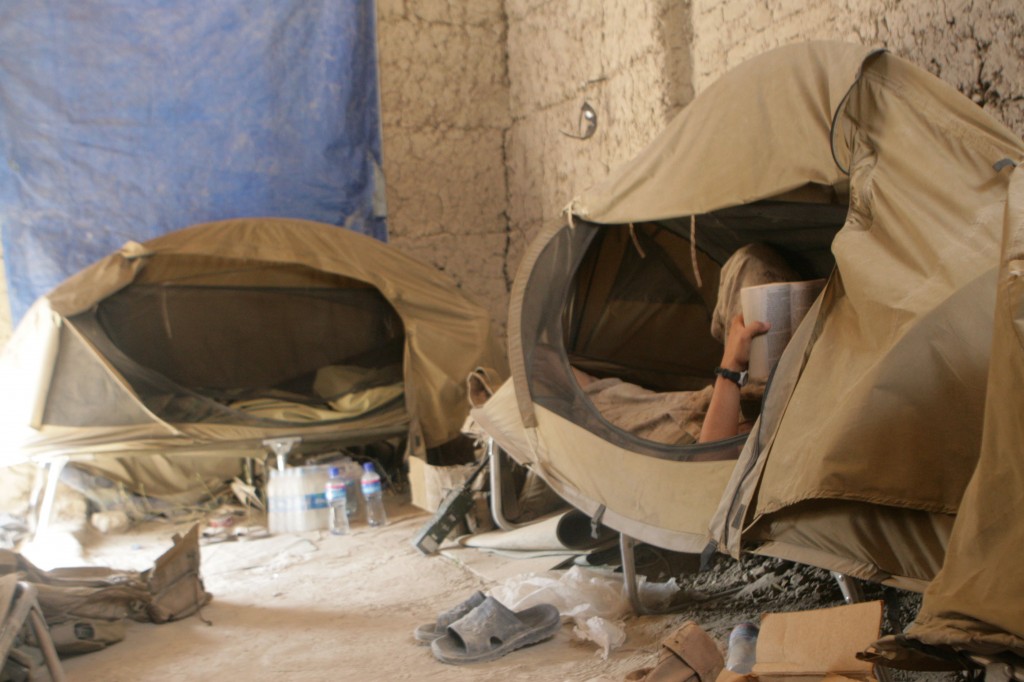Marine Corps Distributed Operations in Afghanistan
BY Herschel SmithThose who follow military doctrine closely know about Commandant Conway’s push to distributed operations within the context of smaller units. Heretofore, the Battalion Landing Team was the smallest unit fielded from ship to shore for which the Corps was prepared to provide logistical and communications support. The combined arms concept has generally been applied at the Marine Air Ground Task Force level. Defensetech recently had an interesting article on The Incredible Shrinking Marine Air Ground Task Force.
The Marines appear to be leading the innovation and thought experimentation on adapting small units to battle hybrid enemies – state and non-state armed groups mixing guerrilla tactics with advanced weaponry.
Down at the Marine Corps Warfighting Laboratory in Quantico, they’re fleshing out an emerging warfighting concept called “distributed operations”: small units operating independently, at a fast paced, fluid tempo when either dispersed or concentrated. Think here of German sturmtruppen tactics from World War I, or, more recently, Hezbollah fighters operating in small dispersed, yet highly lethal, groups in the 2006 Lebanon war.
The director of the Marine’s thought lab, ret. Col. Vincent Goulding, has a piece in the new Proceedings (subscription only) discussing the experimental Marine company landing team (CLT), a reinforced rifle company intended to be the “centerpiece” of future Marine operations, along with a good TO&E. Although, missing from the chart is a 155mm M777 towed howitzer platoon.
The CLT is off to Hawaii in July where it will maneuver from the sea onto some lush, tropical simulated battlefield to conduct distributed operations against a hybrid threat. Tests will look for capability gaps and whether the company headquarters can handle calling in fires, handling logistics and directing the company’s platoons.
[ … ]
Marine Lt. Col. Roger Galbraith asks whether the CLT is the right size, and has a good comments going in the comments thread. “This is a big deal for us because we normally think only of battalion-sized units as being able to operate independently. In addition, we’ll be launching the CoLT from over the horizon (20+ miles out), that’s the first time we’re doing this over the horizon thing, although we first talked about it in 1997.…what took us so long?”
Looking at the TO chart, there does appear to be a glaring lack of direct fire weapons; it doesn’t include a Javelin anti-tank missile section. Perhaps the idea is that on-call fires will substitute for direct fire capability. It’s hard to see how that pans out though. Engagement ranges in complex terrain are often too close to effectively use artillery or air strikes.
In reality, teams smaller than a company are now being distributed throughout the battle space in Helmand, whether doctrine has caught up with the idea or not.
From inside of a small compound, known as Patrol Base Khodi Rhom, the Marines of Easy Company, 2nd Battalion, 2nd Marine Regiment, alongside a section of Afghan national army soldiers, patrol an area once known for large amounts of enemy activity in Garmsir District, Helmand province, Afghanistan.
Marines sleep inside of one-man tents perched on top of cots, some stand post at different corners of the compound. One of the Marines pulls a tab on a unit ration to heat up the squad’s breakfast of biscuits, gravy, ham and raspberry swirls-the same breakfast they’ve been eating the past few days. Some Marines conduct physical training on a makeshift pull-up bar made from a tent pole; they do push-ups and jump rope on a cardboard mat.
On April 20, the Marines, along with their regular duties of post and patrol, had a simple mission; to walk two M-240G machine guns to a nearby observation post known as observation post two.
Normally vehicles would be used to move the machine guns from post to post, but because the road nearby Khodi Rhom had not yet been cleared of roadside bombs, the Marines must move most supplies by foot.
“If something happens like communication gear goes down, we need more batteries or need to move things like crew-served weapons, we have to hump it out there,” said Cpl. Aukai I. Arkus, a team leader for Easy Company, 2/2.
Helicopters have brought in food and water lately, but before they made the landing zone safer, the Marines had to carry it in.
To get the machine guns to the OP, the Marines have to move across rough fields full of wheat and poppy and through canals. There are bridges to cross the canals, but the Marines don’t use them due to greater risk of encountering an improvised explosive device.
“In that area, explosive ordnance disposal exploited lots of IEDs,” said Lance Cpl. Derek A. Tomlin, a designated marksman with Easy Co., 2/2. “They went to town blowing up and collecting IEDs.”
Once the Marines have moved the weapons, they return to the PB, crossing over the same kilometer of rough terrain that it took to get there.
The Marines quickly launched another patrol, this time to a small village near the PB, where they had established relationships with local shopkeepers before.
The Marines buy goods from the local shops, which pays off in other ways, since the relationships have been useful for gathering information on the area. They are willing to help out the shopkeepers who are more cooperative by buying more goods from them.
The Marines bring the rice and potatoes they purchase back to the base where a cook from the ANA prepares it, allowing the Marines to take a break from their usual unitized group ration dinner of chicken breast.
“It’s a nice change,” said Tomlin. “What we’ll do is get rice and potatoes and then we’ll have the ANA cook for us since none of us know how to cook.”
The Marines had manned the position for approximately five days and had planned to be relieved the next.
Though the landing zone has been declared safe, the Marines are rarely moved by air, so they have to walk back to Combat Outpost Koshtay once relieved of their duty by another squad.
They are returning to the relative comfort of Koshtay; though that is not to say that they hated their time spent at Khodi Rhom.
“The best thing about being out there is operating at our own pace,” said Arkus. “We can be as aggressive with it as we want. It leaves time for the squad leader to know what’s going on and make decisions. Also, being isolated like that allows the squad to pull together in more instances.”
The PB has allowed the Marines to saturate the surrounding area causing a significant decrease in enemy activity and an increase in locals’ willingness to assist in improving of their villages.
This is a squad-size unit operating away from the FOB. In Fallujah 2007 squad-size units (and even smaller, fire team-size units) were in operation alone. Squads would safely deliver a Scout sniper to his location and pick him up several days later, and a fire team would routinely embed with the Iraqi Police in Fallujah for weeks at a time. This is small – four men.
I don’t think any of this means the end of the Battalion Landing Team or MEUs. but it does mean a lighter Marine Corps. For those who would claim that this is a focus on counterinsurgency in lieu of conventional warfare, I would argue that it is a return to what the Marines have always been. World Wars I and II were anomalies in the history of the Corps.
Over at Defensetech, a commenter named Sven Ortmann shows his ass and makes completely useless, asinine and combative comments. After reading them, I know nothing more about anything, and I want that five minutes of my life back. Sven owes me, and if I ever see him I’ll take it from him. It’s called being pedantic, and commenters like this is why I don’t frequent Defensetech. But commenter Byron Skinner gives us some useful information after suffering through Sven’s hysteria.
This is the Marines getting back to being Marines and not Army clones. Before WWII this is what the marine looked like, small, fast and light. The current enemies are using speed, mobility and terrain knowledge and are winning in Afghanistan.
Technology is the force multiplier here not heavy iron. The Corp. knows that it’s going to be losing personal as the war in Afghanistan winds down. The Corps best NCO’s and Officers are now being cycled through Afghanistan, already 1,300 enlisted and 115 officers have been told they don’t have a career slot in the post Afghanistan Corps, those that don’t go voluntarily, will be RIF’ed.. General Conway is being up front and very Marine about what he is doing.
If some enterprising Marine Corps officer wants to send me a confidential note explaining whether this is on the level, that would be good. Finally, take particular note of this one man tent in Patrol Base Khodi Rhom.
I want one. I really, really want one. Can this be purchased down at the Marine Corps Exchange (MCX) at Camp Lejeune? Anyone? Anyone know of a civilian version of this same tent? I really, really want one.







On August 27, 2010 at 8:53 am, Byron Reber said:
The one man tents are wonderful I couldn’t locate them online so I got mine off a buddy just back from Afghanistan they are even self pitching
On March 26, 2011 at 9:10 am, Knick said:
Are those tents pitched on cots or do they have some sort of systemt to raise them off of the ground? These things look great would love to source one for camping and hiking.
On July 21, 2011 at 4:33 pm, Joel R. said:
no those tents sit on the ground we had them on cots there to stop from flooding if a rainstorm came in but they are great little tents though. how do I know because i was the brother PLT at O.P. achmed a few clicks south of the one in this picture.
On March 5, 2013 at 5:25 pm, William Meador said:
They are the bednet by Catoma Adventure Shelters. http://www.catomaoutdoor.com
On March 6, 2013 at 2:37 pm, jdkchem said:
Easy Co.? When did the Corps begin using the term “easy” in a non-derogatory fashion? I’ve been out a long time but we never would have called ourselves “easy” company. Aside from the fact that I was in weapons company.
I would guess that the reason for not deploying the Javelin with a CLT would be weight.
It sounds like the author of the Afghan story is a little butt hurt at having to hump gear.
On October 21, 2013 at 2:56 am, Jay said:
jdkchem- 2/2 E company goes by EASY. They go by easy company in ode to the Marines who died on the 1st wave into Tarawa. 2/2 Easy company as it was known back then suffered a major blow in the 1st wave going to the beaches of Tarawa. Back in 2002 before deploying into fight during the intial invasion of Iraq a few 2/2 Easy vets from Tarawa came and asked us why we call ourselves Echo and it was good for them back then to call themselves Easy why isn’t good today? 2/2 BN Commander and E company’s CO made it an order that E company goes by Easy.
As an Easy vet we take great pride in our name and its not a dergatory fashion. We have a saying that “it ain’t easy being easy”. Also we enjoy correcting anyone who calls us Echo company.
During 2005 a new CO didnt’ like the term Easy company and when he called the company to attention and to fall out he yelled “Echo company fall out”. Not one Marine moved and we still stood at attention till the CO got his balls together and called us Easy again.